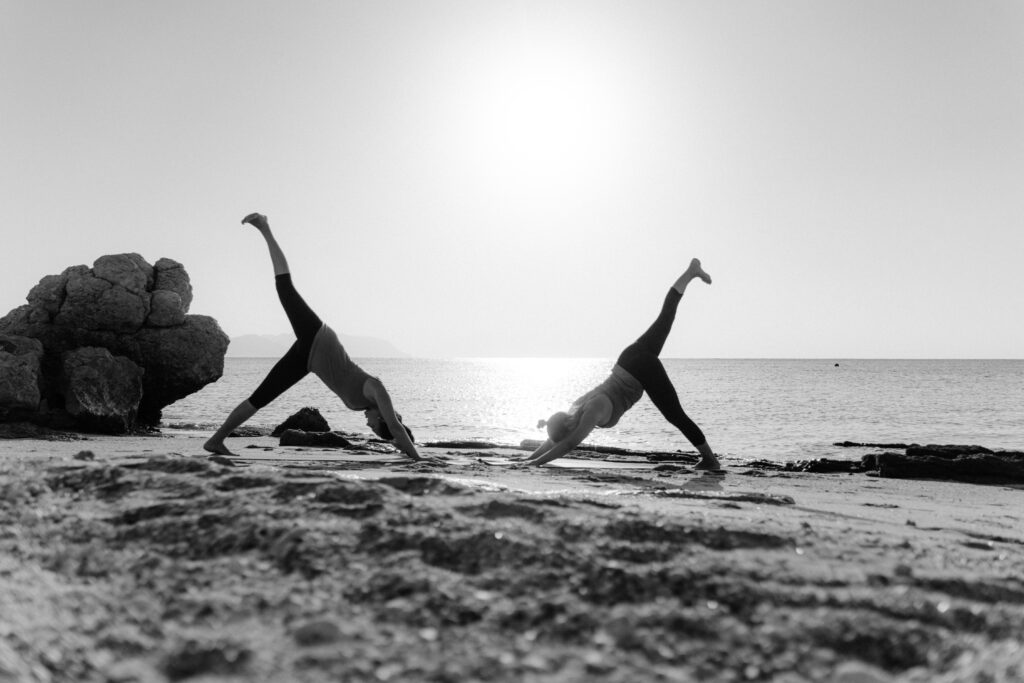As we get ready to step into 2025, many of us will be gearing up to make it their best year yet and set life-improving, meaningful New Year’s resolutions.
What’s more, fitness-related goals will top this list, with research indicating that just under 50% of people commit to improving their health or fitness as part of their resolutions.
And it’s little wonder—exercise is crucial in improving overall health, enhancing mood, and prolonging longevity. But with only a minuscule fraction of individuals keeping to their intentions beyond the first few months of the year, what’s the secret to making objectives you can stay with?

You can position yourself for long-term success and have fun while doing it by employing tried-and-true techniques like setting SMART goals, fostering responsibility, and developing workable plans. Let us dissect it.
How to Create “Stick” Fitness and Health Habits
Setting goals for healthy behaviors is a terrific way to start over in the new year. 2025 may be the year that you make lifelong fitness goals.
The key to success lies in how you approach your New Year’s fitness goals, according to Chris O’Hearn, a personal trainer and life coach at Covenant Health Fitness Center in west Knoxville (Fort Sanders Health and Fitness Center). And we can assist you in achieving your objectives at the four East Tennessee fitness centers operated by Covenant Health. Make this the healthiest year of your life!
- Specific: Vague goals like “get fit” or “exercise more” often fail because they lack clarity. A specific goal clearly defines what you’re aiming to achieve and removes any ambiguity. For example, instead of saying, “I want to improve my fitness,” try “I will walk 8,000 steps every day.” By focusing in on exactly what you want to do, you make it easier to focus your efforts and stay on track.
- Measurable: For you to monitor your progress and recognize your accomplishments, goals must be quantifiable. It is difficult to determine if you are making progress or need to modify your strategy if you do not have a mechanism to gauge success. Say “I will be able to run 3 kilometers non-stop by March 30th” rather than “I want to build endurance.” By demonstrating observable outcomes, this keeps you motivated and provides you with a clear indicator of progress.
- Achievable: For you to monitor your progress and recognize your accomplishments, goals must be quantifiable. It is difficult to determine if you are making progress or need to modify your strategy if you do not have a mechanism to gauge success. Say “I will be able to run 3 kilometers non-stop by March 30th” rather than “I want to build endurance.” By demonstrating observable outcomes, this keeps you motivated and provides you with a clear indicator of progress.
- Realistic: A realistic objective fits your physical capabilities, obligations, and way of life. For example, it might not be possible to strive for daily gym sessions if you are juggling a busy schedule with job and family. Instead, think of something more doable, such as “I will work out twice a week and walk briskly for 20 minutes on three other days.” A long-term sustainable goal is one that aligns with your life.
- Time-Bound: Adding a timeline creates urgency and focus, ensuring your goals don’t drift into “someday” territory. Replace open-ended goals like “I’ll start swimming this year” with “I’ll attend my first swim session by January 15 and continue weekly through April.” Time-bound goals keep you accountable and help you track progress over a specified period.

Creating Action Plans Out of Goals
A SMART objective is a terrific place to start, but it is only an idea without a concrete plan of action. An action plan outlines the where, when, and how of achieving your goal in achievable chunks. It helps you stay on course even when life becomes hectic by converting intention into steady action. Additionally, action plans provide you the ability to change course when things do not work out as expected.
Here’s how to make a practical plan to reach your fitness objectives:
1. Define the details: Ascertain the precise location, time, and method of your exercise regimen. If your objective is to gain strength, for example, your strategy could resemble this:
- Where: On weekdays, at the gym; on weekends, if necessary, at home with resistance bands.
- When: Monday, Wednesday, and Friday evenings at 6:30 PM, or Saturday morning as a backup.
- How: The night before, prepare your gym bag, make a playlist to help you stay motivated, and put reminders on your phone.
2. Anticipate obstacles: Consider any obstacles in advance and how you plan to overcome them. For instance, schedule an early workout if your evenings are frequently erratic. Try working out at home or playing tag-team with a friend or spouse if childcare is a concern. It is simpler to maintain consistency when obstacles are anticipated beforehand.
3. Start small and build: Divide more ambitious objectives into smaller benchmarks. Start with 5,000 steps per day and increase by 1,000 per week if your goal is 10,000 steps per day. This strategy makes it easier to maintain success over time by preventing burnout and boosting confidence.
With Covenant Health, Begin Your Fitness Goals
Do not only make resolutions for the upcoming year. Create a better way of living that will make you look forward to each day for the rest of your life.

Your resolutions can become a reality with Covenant Health’s assistance. You will have the resources you need to thrive with the help of cutting-edge facilities, knowledgeable trainers, and encouraging communities in Knoxville, Fairfield Glade (next to Crossville), Pigeon Forge, and Morristown, Tennessee. Make 2025 the year you reach your full potential!
10 minutes a day of stretching
When you try to move, do you feel stiff? You might wish to resolve to stretch every day. Dr. Shahinaz Soliman, a board-certified family physician, suggests stretching for 10 minutes every day as a practical fitness objective. “Establish a regimen where flexibility and mobility are prioritized to avoid unnecessary injuries,” she advises us.
According to the doctor, a few minutes of stretching included in your daily routine will help avoid restricted joints and stiff muscles. Additionally, stretching might be helpful at other times except right before an exercise. Stretching for ten minutes can “be accomplished before or after exercising or at any point throughout the day,” according to Dr. Soliman. Stretching your calves daily till you can touch your toes could be a SMART goal.
How to stick to your resolution for the new year
Working toward a proactive objective rather than concentrating on self-deprivation may be the key to keeping your New Year’s resolution. A 2020 study that was released in PLoS Approach-oriented and avoidant-oriented goals were tested. Aiming for a favorable result, such as building muscle strength, is known as an approach-oriented goal. Avoidant-oriented goals involve quitting a behavior, such as drinking soda.
Although the study indicated that 59% of persons with approach-oriented objectives were successful, compared to just 47% of those with avoidant-oriented goals, both types of goals have the potential to improve your health.

Logan suggests concentrating on the reason you established your goal in the first palace if you need further inspiration. “Ask yourself what you really want and why before you make goals,” she advises. Think about your motive, for example, if you are thinking of running. Is it to improve your endurance, have fun on outdoor adventures, or stay up with your kids? You may maintain your commitment and focus by being aware of your underlying motive.
Best Things for Fitness in 2025
In 2025, fitness has the power to change your life by impacting not just your physical health but also your mental, emotional, and social well-being. Embracing fitness can have a big influence in the following ways:.
1. Improved Physical Health
- Increased Immunity: Engaging in regular exercise helps strengthen your immune system and lower your risk of contracting diseases.
- Disease Prevention: Being physically fit can help prevent long-term health issues including diabetes, high blood pressure, and heart disease.
- Increased Energy: Maintaining an active lifestyle improves stamina, which makes daily chores less taxing and easier.
2. Mental Clarity and Focus
- Decreased Stress: Endorphins, which are naturally occurring stress relievers, are released during exercise.
- Improved Cognitive Function: Exercises that strengthen the brain, such as yoga and aerobics, improve focus and memory.
- Fighting Depression: Exercise has been shown to reduce anxiety and depressive symptoms.

3. Enhanced Confidence
- Physical Appearance: Your posture and general appearance might be enhanced by reaching your exercise objectives.
- Sense of Achievement: Reaching fitness goals increases one’s sense of self-worth.
4. Social Connections
- Community involvement: Attending gyms or exercise classes exposes you to people who share your interests.
- Support Systems: Talking to people about your fitness travels inspires and motivates you.
5. Longevity and Quality of Life
- Active Aging: As you age, regular exercise helps you stay mobile and independent.
- Happiness: Living a happy and meaningful life is facilitated by having a healthy body.
Action Steps for 2025
- Establish attainable fitness milestones: Establish attainable fitness benchmarks.
- Discover Your Passions: Whether it be weightlifting, swimming, or dancing, pick things that make you happy.
- Remain Consistent: For long-term effects, consistency is more important than intensity.
- Track Progress: To keep track of your progress and maintain motivation, use fitness applications or notebooks.
- Seek Assistance: Join forces with a friend, coach, or online group.
Conclusion
Adopting a fitness lifestyle in 2025 is about discovering a healthier, more satisfying version of yourself, not only about reaching a specific weight or appearance. Fitness may change your life in a variety of ways, from improving your physical and emotional well-being to developing discipline and creating relationships. You can start a path that improves your well-being and enriches your everyday experiences by establishing reasonable goals, remaining persistent, and engaging in things you truly like.
Keep in mind that every step you take, no matter how tiny, is a step in the direction of a happy and healthier self. Make fitness a priority in 2025 and see how it improves your quality of life!